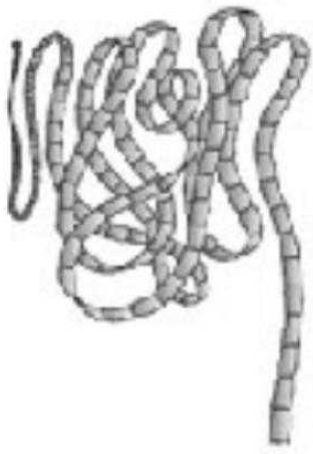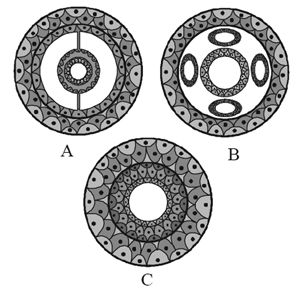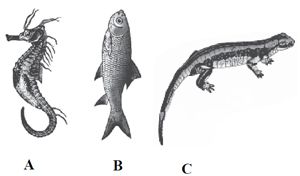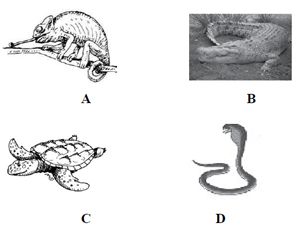Read the following statements and answer the question.
(i) They are exclusively marine, radially symmetrical, diploblastic organisms with tissue level of organisation.
(ii) Body bears eight external rows of ciliated comb plates, which help in locomotion.
(iii) Digestion is both extracellular and intracellular.
(iv) Reproduction takes place only by sexual means.
Which of the following phylum is being described by above statements?
Platyhelminthes
Arthropoda
Mollusca
Ctenophora
Correct Answer :
D. Ctenophora
Ctenophores, also known as comb jellies/sea gooseberries/ sea walnuts, or Venus's girdles, are voracious predators.
Related Questions
Which of the following characteristics is correct for reptilia?
Body covered with dry and cornified skin, scales over the body are epidermal, they do not have external ears.
Body is covered with moist skin and is devoid of scales, the ear is represented by a tympanum, alimentary canal, urinary and reproductive tracts open into a common cloaca.
Fresh water animals with bony endoskeleton and airbladder regulate buoyancy.
Marine animals with cartilaginous endoskeleton and body is covered with placoid scales.
Identify the figure with its correct name and phylum.

Sycon - Porifera
Aurelia - Coelenterata
Pleurobrachia - Ctenophora
Tapeworm - Platyhelminthes
Which of the following is an incorrect statement regarding flatworms ?
They are acoelomates.
They are bilaterally symmetrical.
They lack a digestive system.
They have a circulatory system.
A student brought home a strange animal which he found outside under a rock. It had moist skin, a complete digestive tract, a ventral nerve cord, and had gone through torsion. Identify the phylum of the animal.
Porifera
Annelida
Mollusca
Echinodermata
Refer the following animals and identify those which have a fluid filled body cavity with a complete lining derived from mesoderm.
(i) Sycon (ii) Butterfly
(iii) Nereis (iv) Sea fan
(v) Scorpion (vi) Pila
(i) and (iii) only
(ii) and (iv) only
(ii), (iii), (v) and (vi) only
All of these
__________ is responsible for maintaining the current of water in sponge.
Osculum
Porocytes
Spongocoel
Choanocytes
In phylum echinodermata, the adult echinoderms are ______A__________ but larvae are _______B______ .
A radially symmetrical; B bilaterally symmetrical
A bilaterally symmetrical; B radially symmetrical
A bilaterally symmetrical; B asymmetrical
A metamerically segmented; B asymmetrical
Which of the following is not a characteristic of phylum echinodermata ?
They have a water vascular system.
They have an internal skeleton.
They are protostomes.
They have bilateral symmetry at larval stage.
A file like rasping organ for feeding, called radula, present in the phylum __________.
arthropoda
mollusca
echinodermata
chordata
Refer the types of cells present in some animals. Each cell is specialized to perform a single specific function except
Cnidocytes
Choanocytes
Interstitial cells
Gastrodermal cells
Hemichordates have now been placed with the nonchordates, close to echinoderms, because true
notochord is absent.
pharyngeal gill-slits are lacking.
dorsal nerve cord is absent.
heart is lacking.
Which of the following feature is not correct regarding the figure given below?

It is an aquatic form.
Circulatory system is of open type.
It possesses parapodia for swimming.
Neural system consists of paired ganglia connected by lateral nerves to a double ventral nerve cord.
Which of the following characteristic distinguish arthropoda from annelids and molluscs ?
An external skeleton made of chitin (a polysaccharide) and protein rather than a shell made chiefly of mineral salts.
Subdivision of the legs into movable segments.
Distinct group of muscles, derived from many body segments, that move the separate parts of the exoskeleton.
All of the above
The transition from aquatic to terrestrial lifestyles required many adaptations in the vertebrate lineage. Which of the following is not one of those adaptations ?
Switch from gill respiration to air-breathing lungs.
Improvements in water resistance of skin.
Alteration in mode of locomotion.
Development of feathers for insulation.
Which of the following feature in birds indicates their reptilian ancestory ?
Eggs with a calcareous shell
Scales on their hind limbs
Four-chambered heart
Two special chambers-crop and gizzard in their digestive tract
The following statement are associated with the occurrence of notochord. Identify the incorrect statement.
It is present only in larval tail in ascidians.
It is replaced by a vertebral column in adult frog.
It is absent throughout the life in humans from the very beginning.
It is present throughout life in Amphioxus.
Which of the following is a poisonous snake?
Naja (Cobra)
Bangarus (Krait)
Viper (Viper)
All of these
Identify the figures and select the correct option

A - Pseudocoelomate; B - Coelomate, C-Acoelomate
A - Coelomate, B - Pseudocoelomate, C- Acoelomate
A - Coelomate; B- Acoelomate; C - Pseudocoelomate
A - Coelomate; B- Acoelomate; C-Eucoelomate
Match the phylum given in column - I with their example given in column - II and choose the correct option.
| Column -I | Column- II |
|---|---|
| (Phylum) | (Examples) |
| A. Echinodermata | I. Ascidia, Doliolum |
| B. Hemichordata | II. Asterias, Ophiura |
| C. Urochordata | III. Branchiostoma |
| D. Cephalochordata | IV. Balanoglossus, Saccoglossus |
A IV; B II; C I; D III
A II; B IV; C I; D III
A II; B IV; C III; D I
A II; B I; C IV; D III
Refer the figures A, B and C and choose the correct option which shows animals that regulate buoyancy with the help of air bladder.

A and B
A and C
B and C
All of the above.
Which of the following animals are bilaterally symmetrical?

1 & 2
2 & 4
3 & 4
1 & 3
Which one of the following groups of animals is correctly matched with its characteristic feature without even a single exception ?
Reptilia : possess 3 - chambered heart with one incompletely divided ventricle.
Chordata : Possess a mouth provided with an upper and lower jaw.
Chondrichthyes : Possess cartilaginous endoskeleton.
Mammalia : Give birth to young one.
Which of the following statement(s) is/are correct?
(i) Animals in which the cells are arranged in two embryonic layers, an external ectoderm and an internal endoderm, are called diploblastic animals.
(ii) Notochord is an ectodermally derived rod like structure formed on the ventral side during embryonic development in some animals.
(iii) In some animals, the body cavity is not lined by mesoderm, instead, the mesoderm is present as scattered pouches in between the ectoderm and endoderm and such a body cavity is called pseudocoelom.
Only (i)
Both (i) and (ii)
Both (i) and (iii)
All of these
The given figures A, B, C and D are the examples of first true land vertebrates. They are dominant in mesozoic era and belong to phylum ‘X’. Identify ‘X’ and the animals which have four chambered heart.

X – Reptile; B
X – Reptile; A
X – Amphibia, C
X – Pisces; D
Which of the following possesses electric organs and belongs to class chondrichthyes?
Torpedo
Petromyzon
Trygon
Exocoetus
Which of the following statement(s) is/are correct regarding phylum mollusca?
They are bilaterally symmetrical, triploblastic and coelomate animals.
Body is covered by a calcareous shell and is unsegmented with a distinct head, muscular foot and visceral hump.
The mouth contains a file-like rasping organ for feeding, called radula.
All of the above
In amphibians, heart is ________ chambered.
two
three
four
none of these
Refer the following statement and answer the question. 'Name of X is derived from stinging capsules. It exhibits metagenesis containing two body forms in which sessile and cylindrical form is called Y and umbrella shaped and free swimming is called Z. Identify X, Y, and Z.
X - Coelenterate, Y - Polyp, Z - Medusa
X - Cnidarian, Y - Medusa, Z - Polyp
X - Ctenophora, Y - Radula, Z - Hypostome
X - Porifera, Y - Osculum, Z - Radula
Match the terms/feature given in column I with their examples given in column II and select the correct match from the option given below.
| Column-I | Column-II |
|---|---|
| (Term/Feature) | (Examples) |
| A. Gregarious pest | i. Hirudinaria |
| B. Vector | ii. Planaria |
| C. Oviparous with | iii. Sepia indirect development |
| D. Metameres | iv. Aedes |
| E. High regeneration | v. Locust capacity |
A - i, B - ii, C - iii, D - iv, E - v
A - iii, B - v, C - ii, D - iv, E - i
A - iii, B - i, C - v, D - ii, E - iv
A - v, B - iv, C - iii, D - i, E - ii
Column-I contains organisms and column-II contains their exeretory structures. Choose the correct match form the options given below.
| Column- I | Column -II |
|---|---|
| (Organism) | (Excretory structures) |
| A. Cockroach | I. Nephridia |
| B. Cat fish | II. Malpighian tubules |
| C. Earthworm | III. Kidneys |
| D. Balanoglossus | IV. Flame cells |
| E. Flatworm | V. Proboscis gland |
A I; B III; C II; D IV; E V
A III; B I; C II; D V; E IV
A II; B I; C III; D V; E IV
A II; B III; C I; D V; E IV
